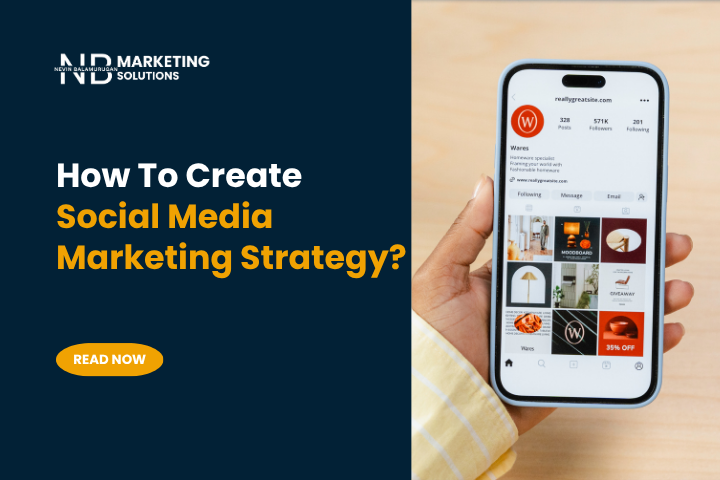How To Create a Social Media Marketing Strategy?
Abirami Dharmalingam
September 30, 2025

Create A Social Media Marketing Strategy With 6 Steps
Creating a perfect social media strategy can be overwhelming. Not anymore!
Today, over 5.41 billion users are scrolling through thousands of posts on social media platforms.
Unfortunately, many small businesses don’t know how to use social media platforms to effectively market their brands. Social media is the right tool to reach more customers, send more traffic to your website, and increase your conversions, too.
But if you want to stand out from your competitors, you need to develop a social media strategy.
With this, you can reach your audience with high-quality content they want to see on the platforms where they’re already spending time. The more specific your plan is, the more effective it can be in achieving your goal.
In this blog, we’ll go over all the steps you need to follow to create a social media strategy for your business.

What is a Social Media Marketing Strategy?
A social media marketing strategy is a plan that outlines how a business will use social media platforms to promote its brand to achieve specific marketing goals (build brand awareness, drive website traffic, target the right audience, or increase sales).
Why You Need a Social Media Marketing Strategy?
You need a social media marketing strategy because it keeps you organized, intentional, and focused on growing the right audience for your business rather than chasing unrelated customers for your brand.
Today, over 5.56 billion internet users use the internet worldwide. That means nearly two-thirds of the global population is scrolling, liking, sharing, and shopping on social platforms. If your target customers are online, chances are they’re already active on social media, too.
Here are some benefits of creating a social media strategy for social media platforms:
Reach your target audience:
Instead of competing with every post, a strategy helps you to create content for your ideal customer (people most likely to engage with your brand). By understanding their demographics, interests, and behaviors, you can meet them where they are (Instagram Reels, YouTube Shorts, Facebook feeds, LinkedIn posts, or TikTok trends).
Builds trust and consistency:
Today’s customers expect brands to be consistent, authentic, and reliable. Over 81% of customers need to trust a brand to consider buying. With a well-defined strategy, your brand voice, visuals, and content can be heard and seen across every social media platform,
Measure your performance:
Without a plan, you can only chase likes and shares. But your social media marketing strategy identifies your key performance indicators (KPIs) that align with your goals, such as engagement rate, click-through rate, conversions, or customer acquisition cost. With this data, you can see what’s working, what isn’t, so you can continuously optimize your strategy.
So, with a plan, your business can risk investing your time and resources in content that drives meaningful impact.
How To Create A Social Media Marketing Strategy With 6 Steps
Here are the steps you need to follow to create a social media marketing strategy for your business.
1. Set clear and measurable objectives
The first step to crafting an effective social media marketing strategy is to define what you aim to accomplish clearly.
Start with your “why.” Why is your brand investing in social media, and what do you want to accomplish in both the short and long term? Asking these questions helps you avoid vanity metrics (like follower counts that don’t convert) and instead focus on results that truly matter to your business.
Some common objectives include:
Boosting brand awareness
Driving website traffic
Generating leads and conversions
Strengthening brand reputation
Building an engaged community
You can have one specific goal or several, but just be sure that each of your goals can be achievable, measurable, and relevant to your brand.
Your goals may be broad at first, but it’s critical to refine them using the SMART framework, making them Specific, Measurable, Achievable, Relevant, and Time-bound.
Once you know why you’re doing this (specific goal), you can be more specific.
2. Identify your audience
Next, you want to know exactly who you’re trying to reach on social media.
Because you can’t create content that resonates if you don’t know who you’re speaking to. If you haven’t identified your buyer personas, start by defining the key demographics of the audience you’re trying to reach, such as age, gender, location, occupation, income, pain points, hobbies, and interests.
To reach your target audience, you must understand what they want and why.
Most importantly, look into what drives them. Are they on social media to learn, to be entertained, to shop, or to stay connected with friends?
HubSpot survey found that 65% of people use social platforms to keep up with friends, 53% use them for entertainment, and 50% use them to learn something new. Only 28% of customers say they actively seek out new products or brands. We know the number might be discouraging.
But when asked how they prefer to research and learn about brands, 41% of consumers said they rely on social media, which is great news for you.
So, by understanding your audience’s pain points, you can create content that meets them where they are instead of interrupting their experience.
So, create your buyer persona template now with these things:
- Demographics: Look at their age, gender, location, job title, income, etc.
- Interests: See what type of content performs better with them? What topics do they engage with?
- Know their goals: Are they looking for information or a purchase? To find a new solution for their problem? To discover a new budget-friendly brand? Think about how your brand, product, or service will be the solution to their problem.
- Platform preference: Look where they hang out on Instagram or YouTube? Or both?
- Content consumption: Do they prefer to watch short-form videos, carousel posts, or quick text posts? Look out for what type of content they are looking for. More importantly, look at what your competitors are following.
With this information, you can inform what content you want to create and where it performs well.
3. Check out your competitors
Now, you have your buyer personas to understand which platforms you want to prioritize.
But before creating your content, check out the social media activity of your competitors or other top companies in your niche. Today, every small to big company depends on social media marketing, so you can learn from them.
Look out:
What type of content are customers engaging with?
Study their profiles and strategies they’re in?
What topics are they covering?
What type of engagement they’re getting on each piece of content.
Which social media platforms are they active?
Which platforms are they not active?
Where are they getting their best results?
More importantly, look out for whether they prefer one platform over another for brand success, or whether your competitors are missing an opportunity with other platforms.
By studying your competitors, you can create great content and spot opportunities in the market to engage with your potential customers.
4. Choose the right social media platforms
Now it’s time to choose the right social media platforms for your brand. Not all platforms are equal, so choose the right platform for your brand.
The most crucial top five platforms: Facebook, X (formerly Twitter), Instagram, YouTube, and LinkedIn. Only focusing on these cannot be right for your brand. So, take a broader view and choose platforms like TikTok, Pinterest, WhatsApp, Snapchat, and more. Who knew your target audience could be here, too?
More important research on where your audience is?
This one question can help you choose the right platform for your brand.
For instance, if you are targeting the Gen Z audience? TikTok, Instagram, and YouTube Shorts might be the best choice for you.
5. Define your brand voice
In a social media marketing strategy, you need to keep up with a consistent brand voice.
So, before you post on social media or develop your content, you need to align with what you’d like your voice to be. Whatever you choose, just look at whether it makes sense in what you’re speaking and who you’re speaking to.
6. Develop a content strategy
Now, it’s time to build a social content strategy, put your audience first, and deliver the types of content they actually want to see. It can be related to information, engagement, or entertainment.
Before you do it, revisit your goals and plan out to create educational videos, product or service videos, reviews, memes, polls, or anything else your audience will find useful. Then, think about the platforms you’re going to be using and notice the trends, content formats, types, and most popular topics.
Here are some tips to build an effective content strategy:
Short-form and long-form content:
- Short-form content: Use Instagram Stories or Reels, TikTok clips, or snappy tweets to grab attention quickly.
- Long-form content: Use blog posts, YouTube tutorials (how-to use), or podcasts to get deep into topics your audience cares about. This can build authority and trust with your audience.
Use high-quality visuals:
- Use compelling images and videos to attract your audience on platforms like Instagram and Pinterest.
- Showcase product or service videos, how-to use, or behind-the-scenes moments to drive engagement.
- Include CTA buttons to guide your audience toward a specific action.
Keep Up With Social Media Marketing Strategy
Social media marketing helps your brand attract an audience more easily. Whether you want more customers to notice your brand or turn visitors into customers, having a clear strategy keeps you focused.
So, keep an eye on what’s working, optimize when needed. Most importantly, connect with your target audience by replying to comments to connect with them and understand their pain points. If you want some help or some guidance, contact NB Marketing Solutions. We’ll help you build a social media marketing strategy that actually helps your brand grow.
Recent Posts
Have Any Question?
- (+91) 938-542-1049
- info@nbmarketingsolutions.in
Categories
Make Appointment
Confused Over Choosing The Right Services For Your Business?
Tamil Nadu, India
- Near TMB Bank, Anjugramam post, Kanyakumari 629401
- info@nbmarketingsolutions.in
- (+91)93-8542-1049
